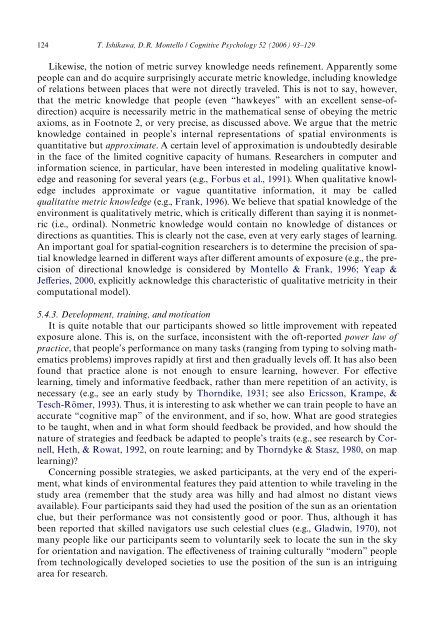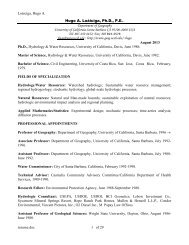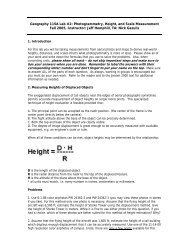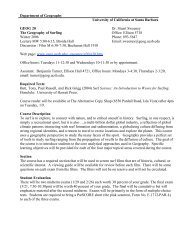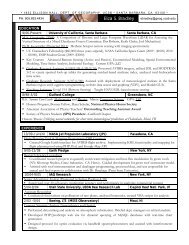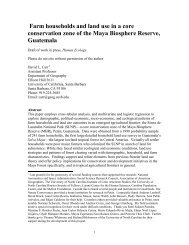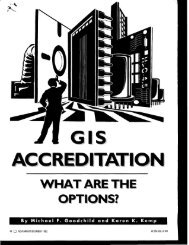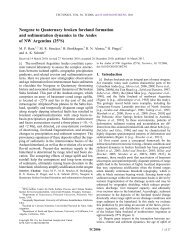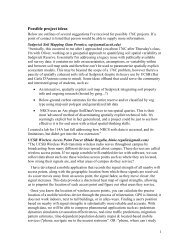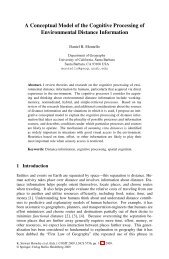Spatial knowledge acquisition from direct experience in the ...
Spatial knowledge acquisition from direct experience in the ...
Spatial knowledge acquisition from direct experience in the ...
You also want an ePaper? Increase the reach of your titles
YUMPU automatically turns print PDFs into web optimized ePapers that Google loves.
124 T. Ishikawa, D.R. Montello / Cognitive Psychology 52 (2006) 93–129<br />
Likewise, <strong>the</strong> notion of metric survey <strong>knowledge</strong> needs reWnement. Apparently some<br />
people can and do acquire surpris<strong>in</strong>gly accurate metric <strong>knowledge</strong>, <strong>in</strong>clud<strong>in</strong>g <strong>knowledge</strong><br />
of relations between places that were not <strong>direct</strong>ly traveled. This is not to say, however,<br />
that <strong>the</strong> metric <strong>knowledge</strong> that people (even “hawkeyes” with an excellent sense-of<strong>direct</strong>ion)<br />
acquire is necessarily metric <strong>in</strong> <strong>the</strong> ma<strong>the</strong>matical sense of obey<strong>in</strong>g <strong>the</strong> metric<br />
axioms, as <strong>in</strong> Footnote 2, or very precise, as discussed above. We argue that <strong>the</strong> metric<br />
<strong>knowledge</strong> conta<strong>in</strong>ed <strong>in</strong> people’s <strong>in</strong>ternal representations of spatial environments is<br />
quantitative but approximate. A certa<strong>in</strong> level of approximation is undoubtedly desirable<br />
<strong>in</strong> <strong>the</strong> face of <strong>the</strong> limited cognitive capacity of humans. Researchers <strong>in</strong> computer and<br />
<strong>in</strong>formation science, <strong>in</strong> particular, have been <strong>in</strong>terested <strong>in</strong> model<strong>in</strong>g qualitative <strong>knowledge</strong><br />
and reason<strong>in</strong>g for several years (e.g., Forbus et al., 1991). When qualitative <strong>knowledge</strong><br />
<strong>in</strong>cludes approximate or vague quantitative <strong>in</strong>formation, it may be called<br />
qualitative metric <strong>knowledge</strong> (e.g., Frank, 1996). We believe that spatial <strong>knowledge</strong> of <strong>the</strong><br />
environment is qualitatively metric, which is critically diVerent than say<strong>in</strong>g it is nonmetric<br />
(i.e., ord<strong>in</strong>al). Nonmetric <strong>knowledge</strong> would conta<strong>in</strong> no <strong>knowledge</strong> of distances or<br />
<strong>direct</strong>ions as quantities. This is clearly not <strong>the</strong> case, even at very early stages of learn<strong>in</strong>g.<br />
An important goal for spatial-cognition researchers is to determ<strong>in</strong>e <strong>the</strong> precision of spatial<br />
<strong>knowledge</strong> learned <strong>in</strong> diVerent ways after diVerent amounts of exposure (e.g., <strong>the</strong> precision<br />
of <strong>direct</strong>ional <strong>knowledge</strong> is considered by Montello & Frank, 1996; Yeap &<br />
JeVeries, 2000, explicitly ac<strong>knowledge</strong> this characteristic of qualitative metricity <strong>in</strong> <strong>the</strong>ir<br />
computational model).<br />
5.4.3. Development, tra<strong>in</strong><strong>in</strong>g, and motivation<br />
It is quite notable that our participants showed so little improvement with repeated<br />
exposure alone. This is, on <strong>the</strong> surface, <strong>in</strong>consistent with <strong>the</strong> oft-reported power law of<br />
practice, that people’s performance on many tasks (rang<strong>in</strong>g <strong>from</strong> typ<strong>in</strong>g to solv<strong>in</strong>g ma<strong>the</strong>matics<br />
problems) improves rapidly at Wrst and <strong>the</strong>n gradually levels oV. It has also been<br />
found that practice alone is not enough to ensure learn<strong>in</strong>g, however. For eVective<br />
learn<strong>in</strong>g, timely and <strong>in</strong>formative feedback, ra<strong>the</strong>r than mere repetition of an activity, is<br />
necessary (e.g., see an early study by Thorndike, 1931; see also Ericsson, Krampe, &<br />
Tesch-Römer, 1993). Thus, it is <strong>in</strong>terest<strong>in</strong>g to ask whe<strong>the</strong>r we can tra<strong>in</strong> people to have an<br />
accurate “cognitive map” of <strong>the</strong> environment, and if so, how. What are good strategies<br />
to be taught, when and <strong>in</strong> what form should feedback be provided, and how should <strong>the</strong><br />
nature of strategies and feedback be adapted to people’s traits (e.g., see research by Cornell,<br />
Heth, & Rowat, 1992, on route learn<strong>in</strong>g; and by Thorndyke & Stasz, 1980, on map<br />
learn<strong>in</strong>g)?<br />
Concern<strong>in</strong>g possible strategies, we asked participants, at <strong>the</strong> very end of <strong>the</strong> experiment,<br />
what k<strong>in</strong>ds of environmental features <strong>the</strong>y paid attention to while travel<strong>in</strong>g <strong>in</strong> <strong>the</strong><br />
study area (remember that <strong>the</strong> study area was hilly and had almost no distant views<br />
available). Four participants said <strong>the</strong>y had used <strong>the</strong> position of <strong>the</strong> sun as an orientation<br />
clue, but <strong>the</strong>ir performance was not consistently good or poor. Thus, although it has<br />
been reported that skilled navigators use such celestial clues (e.g., Gladw<strong>in</strong>, 1970), not<br />
many people like our participants seem to voluntarily seek to locate <strong>the</strong> sun <strong>in</strong> <strong>the</strong> sky<br />
for orientation and navigation. The eVectiveness of tra<strong>in</strong><strong>in</strong>g culturally “modern” people<br />
<strong>from</strong> technologically developed societies to use <strong>the</strong> position of <strong>the</strong> sun is an <strong>in</strong>trigu<strong>in</strong>g<br />
area for research.


